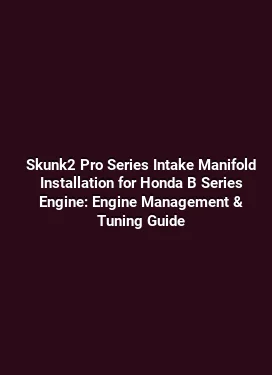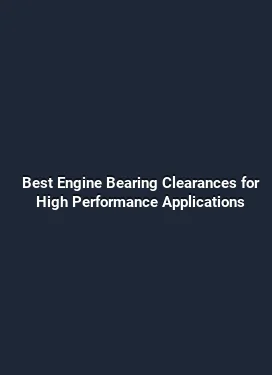How to Degree Camshafts for Maximum Power Output: A Complete Tutorial for Engine Management & Tuning
The process of degreeing camshafts is a cornerstone of precision engine tuning. It involves aligning the camshaft lobe centers with the engine's timing marks to achieve the exact valve opening and closing events that maximize power while maintaining reliability. This guide dives into the practical, hands-on aspects of camshaft degreeing, offering real-world steps, measurement techniques, and tuning considerations that go beyond theory. Readers will explore how valve timing interacts with compression, intake and exhaust port dynamics, and fuel/air management to extract horsepower without compromising engine longevity.
Understanding Camshaft Degreeing and Its Impact on Power

Camshaft degreeing refers to the process of precisely setting the camshaft position relative to the crankshaft. Each cam lobe has a duration and a lift profile that determines when the valves open and close. In high-performance applications, even a few crankshaft degrees of variance can shift torque production across the RPM range, altering peak power, throttle response, and overall drivability. The goal is to align the intended timing with the engine’s dynamic behavior under load, airflow limits, and fuel delivery characteristics.
There is a natural trade-off between aggressive timing for peak power and the risk of detonation or valve instability. A well-degreeed cam profile blends strong mid-range torque with high-end horsepower while preserving safe ignition timing, injector ramp rates, and cooling capacity. This requires careful measurement, a clear understanding of the engine’s breathing capabilities, and a tuning strategy that integrates manifold pressure, air-fuel ratio targets, and ignition curves.
Valve Timing Fundamentals and How They Drive Power

Valve timing directly influences the amount of air and fuel that enters the cylinder and the exhaust gases that exit. The precise moment when intake valves begin to open (IVO) and close (IVC), as well as when exhaust valves open (EVO) and close (EVC), defines the effective duration and the overlap between intake and exhaust events. Longer duration can boost high-RPM airflow but may reduce low-end torque. Lobe separation angle (LSA) and lobe centerline (LCA) are geometric concepts that describe how the cam profile is positioned relative to the piston cycle. By degreeing the cam, tuners can place the valve events at the most beneficial points in the engine’s work cycle for the target RPM range.
In naturally aspirated engines, optimal events typically favor wide high-RPM air utilization, whereas forced induction setups may require different balance to manage boost onset and volumetric efficiency. The practical takeaway is that cam degreeing must consider the entire intake/exhaust system, fuel delivery, ignition strategy, and cooling availability to achieve the target power plateau without compromising reliability.
Measuring Tools and Safety Considerations
A precise degreeing process starts with the right tools: a dial indicator, a degree wheel, a timing pin or known reference mark, and a solid mounting surface for the degree wheel. A top-dead-center (TDC) reference for each cylinder is essential. Safety comes first: disconnect the ignition, relieve any fuel pressure, and verify that the engine cannot start during setup. When measuring, use a known reference point on the crank pulley and a reliable piston stop or dial indicator to confirm TDC with repeatable accuracy. Document all readings, as small discrepancies can compound across multiple cylinders and lead to inconsistent results.
Proper alignment also means verifying the camshaft timing gear or belt alignment marks. Some engines use sprocket alignment keys or tensioner positions as reference points. Always recheck after loosening any fasteners, as the process can cause belt guides to shift slightly. The degreeing procedure should be performed for each camshaft in multi-cam setups, ensuring that both intake and exhaust profiles meet the target timing simultaneously.
Practical Steps to Degree Camshafts for Maximum Power
Executing a successful cam degreeing workflow requires a structured approach. The steps below outline a repeatable method that balances accuracy with efficiency while delivering a robust power-focused result. Adaptation to your specific engine platform (DOHC, SOHC, pushrod, or flat-head) is essential, but the core principles remain consistent across architectures.
1) Establish a Reliable Base Measurement
Begin by identifying the engine’s stock timing reference points and establishing a clean base. Set the crankshaft to TDC on the cylinder being tested, then record the exact position of the cam lobes relative to the crankshaft mark. If the engine uses variable timing or a drive-by-wire throttle with electronic control, note how actuator positions correlate with mechanical timing at idle and baseline RPM. Documenting this baseline is critical for diagnosing deviations after install or maintenance work.
At this stage, confirm piston position with a dial indicator on the cam lobe or valve lash clearance method. A repeatable baseline reduces the risk of misinterpretation when comparing to the target degrees. If the baseline shows a large discrepancy from the intended factory spec, inspect for timing belt or chain wear, cam gear backlash, or tensioner sag before proceeding.
2) Determine Target Housekeeping for Duration and Overlap
Decide on the duration and overlap ranges that align with the desired power band. For naturally aspirated setups targeting wide torque production, a moderate increase in duration coupled with controlled overlap can improve mid-range flow without starving the bottom end. For boosted applications, tighter overlap can help mitigate high-intake temperatures and prevent scavenge losses. The key is to translate the intended air-fuel mixture behavior into a cam profile that keeps the engine breathing efficiently through the RPM span.
When choosing target values, consider the intake manifold design, runner length, turbocharger or supercharger sizing, intercooling efficiency, and exhaust geometry. A larger turbo may demand slightly later intake timing to prevent boost-induced detonation, while a naturally aspirated high-compression setup might benefit from earlier intake events to maximize cylinder fill at higher RPMs.
3) Perform Progressive Degreeing and Reconcile Cylinder-to-Cylinder Variations
With the cam timing set to the target degrees, re-check each cylinder reference point for consistency. In DOHC engines, small differences between banks can arise due to machining tolerances or chain/belt tension differences. Record the measured degrees per cylinder and identify any consistent offset across cylinders. If significant variance exists, adjust using the cam gear positions or the camshaft phasers if the design includes them. Progressive degreeing ensures that the valve timing across cylinders aligns with the engine’s overall dynamic response, not just a single test point.
After adjusting, cycle the engine multiple times to settle the mechanical parts. Rejoint the test to cold conditions if the engine was hot, since heat expansion can shift measurement references slightly. By compiling a matrix of readings, a tuner can map out the most uniform timing profile while preserving peak power targets across the RPM range.
4) Validate with Dynamic Testing and Data Integration
Static degreeing is only part of the story. Dynamic validation involves logging data during controlled pulls on a dynamometer or a high-quality chassis dyno. Monitor air-fuel ratio, manifold pressure, ignition advance, and boost (if applicable). Use torque curves to verify that the degreeing changes yield the intended improvements in the mid-to-high RPM band without sacrificing low-end response or high-RPM stability. Semantically meaningful data patterns—such as sustained torque increments and smooth ignition curves—signal effective timing adjustments.
Integrate this data with a flexible engine control map. Modern engines often rely on adaptive management, so the final timing strategy may shift slightly under load or temperature changes. While the goal is a stable, repeatable power curve, maintaining a margin for fuel timing and knock control ensures reliability across driving scenarios.
Advanced Tuning Scenarios: From Street to Track
Engine tuning for maximum power is context-specific. Street-legal setups require a balance between performance and drivability, while track-oriented builds push for aggressive power with robust reliability margins. The following scenarios explore how cam degreeing interacts with common configurations and how to tune for distinct environments.
Naturally Aspirated High-Compression Engines
In high-compression engines, early intake events can fill the cylinder efficiently at higher RPMs, but too much duration can hamper cold-start and idle stability. Degreeing to a slightly later intake onset and keeping a moderate lobe separation can improve peak power while preserving a clean idle and good throttle response. Pay attention to valley temperatures and detonation margins, especially in hot climates or with limited fuel octane.
Forced Induction Setups
Forced induction systems introduce additional variables, including boost onset and intercooler efficiency. Cam timing that favors quick boost response can help reduce turbo lag and improve low- to mid-RPM torque. However, excessive duration or overlap can erode high-velocity flow at higher boost and raise exhaust gas temperatures. A practical approach is to aim for a balanced overlap that minimizes raw exhaust reversion while preserving intake efficiency under boost.
Variable Timing and Phased Cam Systems
Many modern engines utilize variable valve timing or phasers to adjust timing on the fly. Degreeing in stationary conditions still matters because it provides a baseline for the ECU’s adaptive strategies. When integrating with phasers, ensure the static timing envelope aligns with the phaser’s operational range. This alignment helps the control system land on a stable map even as under-hood temperatures and fuel quality shift during a drive cycle.
Common Pitfalls and How to Avoid Them
The journey to maximum power through cam degreeing is fraught with potential missteps. Awareness of typical challenges can save time and prevent costly mistakes. The following list highlights practical issues and proven workarounds that seasoned tuners employ during the degreeing process.
Inaccurate Reference Points
Using inaccurate TDC references or misinterpreting cam gear marks is a frequent cause of error. Always verify TDC with multiple methods and double-check the crank reference against the cam position with a dial indicator. A tiny misread can cascade into hours of rework and suboptimal power delivery.
Backlash and Gear Play
Excessive lash in timing gears, chains, or belts can cause apparent timing deviations once load is applied. Measure backlash with patience, and ensure components are within specification. Replacing worn tensioners or gears can stabilize results and prevent drift under temperature changes.
Overlooking Thermal Effects
Temperature influences alloy expansion and seal behavior, subtly shifting timing references during a test. Conduct measurements at a repeatable temperature, or account for thermal variance when interpreting results. In some cases, adjustments may be necessary for different operating temperatures to preserve performance across a drive cycle.
Fuel and Ignition Coordination
Timing advances must be matched with appropriate fuel delivery and ignition settings. A misalignment between timing and spark energy can mask the true gains of a degreeing effort and may increase the risk of knock. Ensure a safe ignition map and robust fuel control during tests, especially at high load levels.
Real-World Case Studies: Lessons from the Pit Lane
Hands-on experiences from performance shops and amateur builders illustrate the tangible impact of careful cam degreeing. Case studies cover engines ranging from small-displacement turbocharged four-cylinders to large displacement naturally aspirated V8s. In each instance, systematic measurement, disciplined documentation, and iterative testing produced measurable gains in power and throttle response. The takeaway is that methodical degreeing, combined with a disciplined data-driven approach, yields repeatable results across platforms and use cases.
One notable example involved a turbocharged inline-four where a modest increase in intake duration and a slight shift in LSA improved mid-range torque by several percent without compromising idle stability. Another case highlighted a V8 with aggressive cam lobe profiles where careful phasing reduced peak exhaust temperatures and preserved valve seat integrity under sustained track use. These examples underscore the value of aligning cam timing with breathability limits and the engine’s thermal management plan.
Best Practices for Long-Term Reliability and Performance
Beyond achieving peak power, a well-executed cam degreeing strategy should prioritize engine health and durability. Regular maintenance of timing components, consistent lubrication, and monitoring of temperature and ignition stability contribute to sustainable performance gains. When planning a degreeing project, include a maintenance checklist, a revision plan for fuel maps and ignition curves, and a testing protocol that confirms the stability of the power curve over a range of operating conditions.
Incorporating trend-driven insights and data-driven adjustments helps sustain performance in varying environments. Track day data, street driving logs, and long-term reliability indicators all inform future tuning decisions. The end result is a precise, repeatable timing strategy that consistently unlocks greater power while maintaining control and safety under all driving scenarios.
Conclusion: Integrating Cam Degreeing into a Holistic Tuning Plan
Camshaft degreeing is more than a one-off adjustment; it is a core element of a holistic tuning workflow. By aligning mechanical timing with air intake dynamics, fuel delivery, ignition management, and thermal constraints, a tuner can realize meaningful gains in power and throttle response. The process benefits from a disciplined approach to measurement, documentation, and validation, ensuring that improvements translate from the dyno to real-world driving conditions without compromising reliability.
As engines evolve with advanced materials, smarter control systems, and more sophisticated sensing, the principles of precise timing remain foundational. By embracing a rigorous degreeing methodology and integrating it with a robust data-driven tuning strategy, enthusiasts and professionals can push the envelope of performance while preserving engine longevity and driveability.






